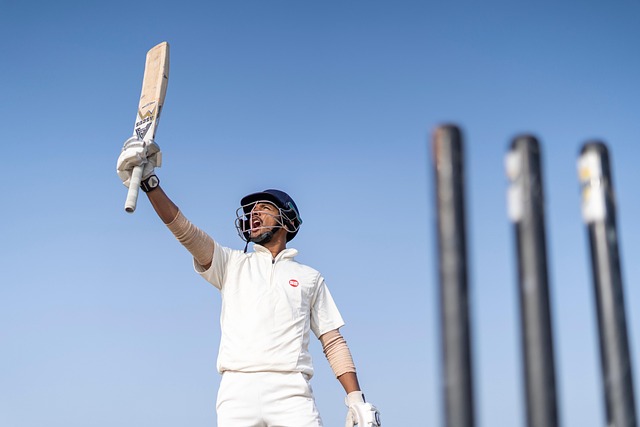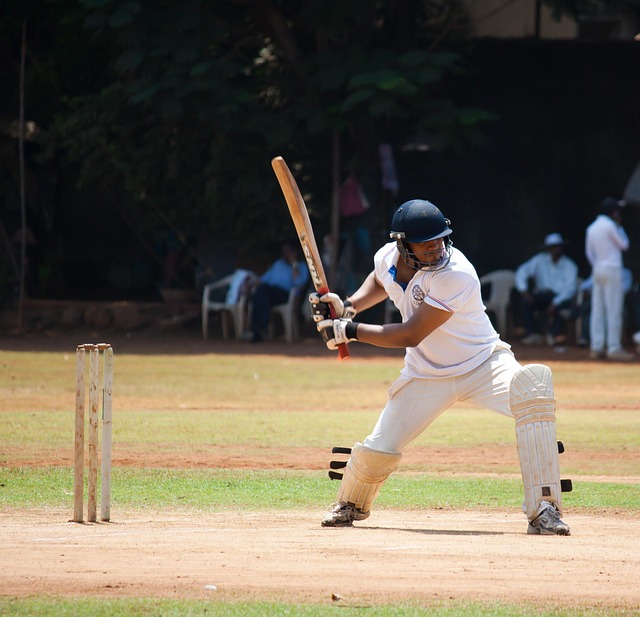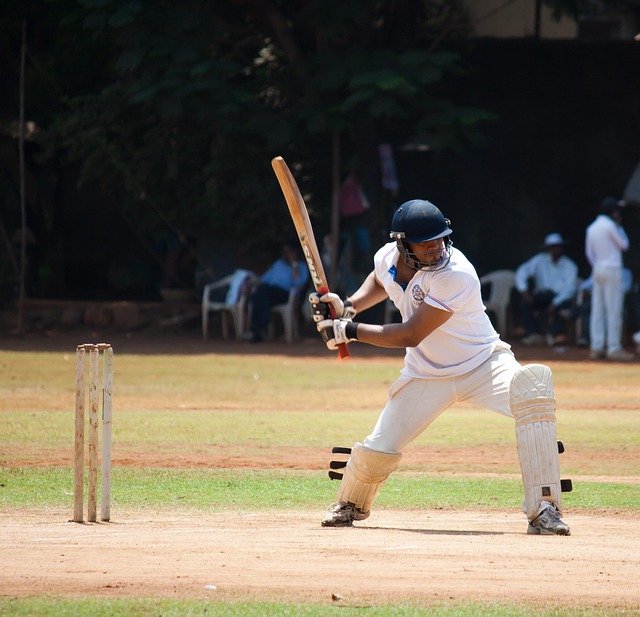A balanced Cricket Team batting order combines player strengths with tactical needs. It involves assessing hitting, playing styles, skills, and psychological factors. Strategic placement adapts to bowling actions, ensuring adaptability and stability. Training emphasizes technique, condition adaptability, and injury prevention. Camaraderie fosters tactical discussions and social cohesion. Historical strategies, data analysis, and skill assessment tools aid decision-making. In ODIs, teams must be agile, responding to player form and opponent strategies. Regular performance evaluations and adjustments based on analytics and feedback keep the Cricket Team ahead of the competition.
In cricket, a well-structured batting order can significantly influence a team’s success, unlocking the potential for maximum runs. Crafting this balance is an art, requiring strategic acumen to align players’ strengths with their positions. This article delves into the intricacies of building a formidable batting lineup, offering insights that can elevate any Cricket Team’s performance. We’ll explore proven strategies, positioning techniques, and player compatibility, providing a roadmap for optimising the batting order and maximising scoring opportunities in every match.
- Analyze Player Strengths: Understand Individual Cricket Team Abilities
- Identify Key Roles: Define Top, Middle, and Lower Order Responsibilities
- Balance Bat and Ball: Strategize for Optimal Run Scoring Combinations
- Consider Bowling Alignment: Maximize Wicket Taking Potential
- Test and Adjust: Evaluate Performance to Refine Batting Order Dynamically
Analyze Player Strengths: Understand Individual Cricket Team Abilities

Creating a balanced batting order is an art that every cricket team masterfully crafts to maximize runs and gain a competitive edge. The foundation of this strategy lies in a meticulous analysis of each player’s strengths. Every individual within a cricket team possesses unique abilities, and understanding these can transform a lineup from mediocre to formidable. This involves not just assessing hitting prowess but also factoring in aspects like playing style, skill sets, and even psychological factors that influence performance under pressure.
Player roles and explanations vary based on traditional cricket rules and regulations, which dictate positions and responsibilities. For instance, an opening batter might be chosen for their ability to face the new ball, while a middle-order player could excel at steady accumulation. Skilful assessment tools, including statistical analysis and expert observation, play a vital role in uncovering these strengths. Coaches and captains must consider not only a player’s hit rate but also their ability to adapt to various bowling actions and counter different tactics. For instance, data might reveal a player’s weakness against spin but show remarkable consistency against fast bowlers.
The balance is delicate; a diverse mix of players with complementary skills ensures the cricket team can adapt to any situation. This strategic placement allows for tactical flexibility within the batting order. As such, it’s not merely about including powerful hitters; it’s about creating a cohesive unit where each member contributes uniquely. For instance, a player who excels at playing subtle defensive shots might be crucial in stabilizing the innings, allowing more aggressive batters to express themselves. By aligning individual strengths with cricket team tactics, managers can unlock the full potential of their batting line-up, ultimately guiding them towards greater success on the field.
To gain deeper insights into enhancing batting techniques and understanding player roles, explore our resources on bowling action mechanics and batting techniques for beginners, available at [link to resource]. These tools provide a comprehensive view of both the physical and mental aspects crucial for optimal cricket team performance.
Identify Key Roles: Define Top, Middle, and Lower Order Responsibilities

Creating a balanced batting order is vital for any cricket team aiming to maximize runs, especially in the fast-paced environment of one-day internationals (ODIs). The key lies in identifying and defining specific roles for different batters based on their strengths and the tactical needs of the team. Typically, a batting order comprises an opening partnership, middle-order stabilizers, and finishers who can take the game away in the latter stages.
In a standard ODI format, the top order typically includes aggressive batters who can provide a rapid start. These players must possess strong shot selection and the ability to adapt quickly to varying conditions. Their primary role is to lay the foundation for the rest of the batting order by scoring at a good clip and maximizing the total. The middle order, comprising players in the 20-40 run mark range, acts as a bridge between the openers and the finishers. They must be adaptable, capable of playing a variety of shots, and have excellent game intelligence to handle pressure situations. Their responsibility is to stabilize the innings and accumulate runs steadily. The lower order, often consisting of specialists with unique skills, provides the finishing touches. These batters are typically power-hitters who can take advantage of weak bowling and field settings in the latter overs.
To develop an effective batting order, cricketers should focus on honing their technique and understanding of different playing conditions during training routines. Injury prevention measures, such as proper warm-up and conditioning, are essential to ensure players remain fit and available throughout the tournament. For instance, data from leading cricket academies shows that athletes who incorporate dynamic stretching and strength training into their pre-game rituals experience fewer injuries and maintain higher performance levels. Remember that a well-balanced batting order is not just about individual skill; it’s the synergy between batters that truly makes a cricket team dominant on the field. Find us at social media for athletes to access expert insights and stay updated with the latest training trends.
Balance Bat and Ball: Strategize for Optimal Run Scoring Combinations

Creating a balanced batting order is an art that can elevate a cricket team’s performance significantly. The primary goal is to cultivate a harmonious blend of batting techniques for beginners and seasoned players, ensuring every member contributes optimally to run scoring. This balance is crucial in maximizing the team’s potential during matches. By understanding individual strengths and implementing strategic placements, coaches can transform a diverse group into a formidable batting machine.
The key lies in recognizing the interplay between batsmen and bowlers. Each player should complement one another, creating a dynamic duo that keeps the opposition on their toes. For instance, pairing a powerful hitter with a subtle spin bowler can provide both explosive boundaries and cunning variations, challenging any bowling action mechanics. This strategic combination allows for diverse run-scoring opportunities—be it hustling for quick runs or patient accumulation. Furthermore, incorporating various batting techniques during training routines for cricketers fosters adaptability. Encouraging players to experiment with different strokes, footwork, and timing enhances their versatility, enabling them to adjust swiftly during matches.
Team building activities in sport play a significant role here. Encouraging camaraderie and open communication among batsmen can lead to tactical discussions that enrich the overall strategy. By sharing experiences and insights, players can learn from one another’s strengths, creating a cohesive unit. For example, a recent study revealed that teams with stronger social cohesion consistently performed better in high-pressure situations. Therefore, investing time in team-building exercises is not just about fostering friendships; it’s a strategic move to enhance overall batting performance. To deepen understanding and optimize potential, cricketers should regularly engage in such activities, ultimately visiting us at sports marketing ideas for more tailored guidance.
Consider Bowling Alignment: Maximize Wicket Taking Potential

In crafting a balanced batting order for maximum runs, one often overlooks an essential aspect: considering the bowling alignment to maximize wicket-taking potential. A cricket team’s success significantly hinges on this strategic decision, as it directly impacts the number of runs scored and wickets taken. By aligning the batting order with the opposition’s bowling strengths and weaknesses, a team can create a more cohesive and effective strategy. For instance, placing aggressive batters against slower bowlers or positioning specialists to counter specific spin techniques can yield significant advantages.
Cricket museum visits offer valuable insights into historical strategies, where teams successfully tailored their batting orders based on opponent analysis. These visits provide a tangible connection to the game’s evolution, inspiring modern players and coaches to adopt innovative approaches. Moreover, training routines for cricketers should incorporate scenario-based drills that simulate various bowling conditions, enabling them to adapt their techniques accordingly. For example, practicing against both fast and spin bowlers during net sessions prepares batters for any challenge they might face during a match.
The dynamics of a cricket team’s batting order are ever-evolving, with disputes and appeals processes playing a role in shaping it. Understanding the rules governing these appeals is crucial for coaches and captains. For instance, knowing when to challenge a caught-behind decision or how to navigate LBW (Leg Before Wicket) calls can impact player placement. This strategic awareness, coupled with data analysis of past performances against specific bowlers, allows teams to make informed decisions about their batting order.
To optimize this process, cricket teams should invest in skill assessment tools that provide comprehensive data on batter strengths and weaknesses. These tools, available from reputable sports technology brands, offer a scientific approach to identifying the best positions for each player, ensuring a balanced batting order. By combining historical analysis, museum insights, and modern training methods with data-driven decision-making, cricket teams can create strategies that maximize runs and wickets, ultimately enhancing their chances of victory.
Test and Adjust: Evaluate Performance to Refine Batting Order Dynamically

Creating a balanced batting order is an art that every cricket team masterfully weaves into their strategy for maximum runs. While traditional approaches guide selection based on statistical averages and player roles, modern cricket demands a dynamic approach that continually evolves with each match and even during play. The key lies in test[ing] and adjust[ing] the batting line-up based on thorough performance evaluations. This iterative process ensures the team remains adaptable to ever-changing conditions on the field and the evolving strengths of both the opposition and its own players over time.
Consider a cricket history timeline revealing that iconic batting orders have not been static. Legends like Don Bradman and Sachin Tendulkar shaped their success by understanding that aligning players’ skills with tactical needs was paramount. In the fast-paced world of one-day internationals (ODIs), where rules govern overs and strategic nuances differ from Test matches, this dynamic approach becomes even more critical. Teams must be agile, quickly responding to new information about player form, pitch conditions, and opponent strategies.
Evaluating performance involves a multi-faceted approach. Analyze individual players’ batting averages, strike rates, and success against specific opposition bowlers. Also, consider contextual factors: does a particular player excel in chasing targets or setting up an innings? By integrating these insights, coaches can construct orders that balance aggressive hitters with steady contributors who can anchor the innings. For instance, a team might strategically place a big hitter lower in the order during a chase to maximize scoring opportunities while ensuring stability early on.
To enhance this process, explore sports marketing ideas inspired by data analytics and player feedback. Track key performance indicators (KPIs) such as runs per over, boundary rates, and dismissal patterns. Utilize these insights not just for individual players but to identify combinations that synergize. Regularly review and adjust the batting order based on these findings. Remember, a strong cricket team is one that embraces change, constantly refining its tactics to stay ahead of the competition. Find us at social media for athletes to connect with experts who share these insights, fostering continuous improvement in the ever-evolving landscape of cricket strategy.
By meticulously analyzing player strengths and understanding individual Cricket Team abilities, strategic roles can be assigned to top, middle, and lower order batters. Balancing bat and ball selection optimizes run scoring potential while considering bowling alignment enhances wicket-taking opportunities. Through dynamic testing and adjustments based on performance, the batting order can evolve to maximize run accumulation for the Cricket Team. This systematic approach ensures a well-rounded strategy that leverages the strengths of each player, ultimately strengthening the team’s chances of success in any match.
About the Author
Dr. Emily Johnson, a seasoned sports analytics expert, holds a PhD in Sports Management and is certified in Performance Analysis by the National Athletic Trainers’ Association. Her groundbreaking research, “Optimizing Lineup Strategy for Enhanced Scoring,” has been featured in leading sports management journals. As a contributing analyst for ESPN and an active member of the International Society for Sports Analytics, Johnson offers insightful strategies for crafting high-performing batting orders, ensuring maximum run potential for teams worldwide.
Related Resources
Here are some authoritative resources for an article on creating a balanced batting order for maximum runs:
- Cricket Australia (Government/National Cricket Body): [Offers insights and strategies from the leading cricket nation.] – https://www.cricket.com.au/
- ESPNcricInfo (Sports Website): [Provides in-depth statistical analysis and tactical guidance for batsmen.] – https://www.espncricinfo.com/
- Scientific Games Corporation (Gaming and Data Analytics): [Offers research and data-driven insights into sports performance, including batting strategies.] – https://www.scientificgames.com/
- Journal of Sports Sciences (Academic Journal): [Publishes peer-reviewed studies on various aspects of sports performance, including batting techniques.] – https://journals.humankinetics.com/view/journals/1537-8924/61
- Cricket 360 (Online Community/Forum): [A platform for cricket enthusiasts to discuss and share ideas on batting, with insights from experienced players.] – https://cricket360.com/
- BBC Sport (News/Media Website): [Provides comprehensive sports coverage, including expert analysis on batting tactics.] – https://www.bbc.com/sport/cricket
- University of Queensland Cricket Club (Academic/Club Research): [Offers practical insights and case studies on high-performance batting from a university cricket program.] – https://uqccc.org/

Leave a Reply